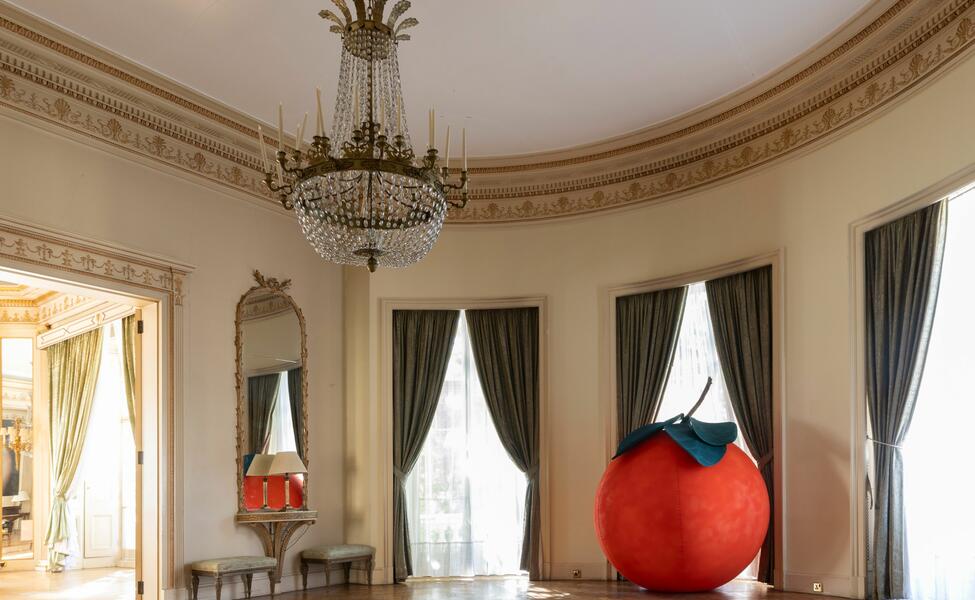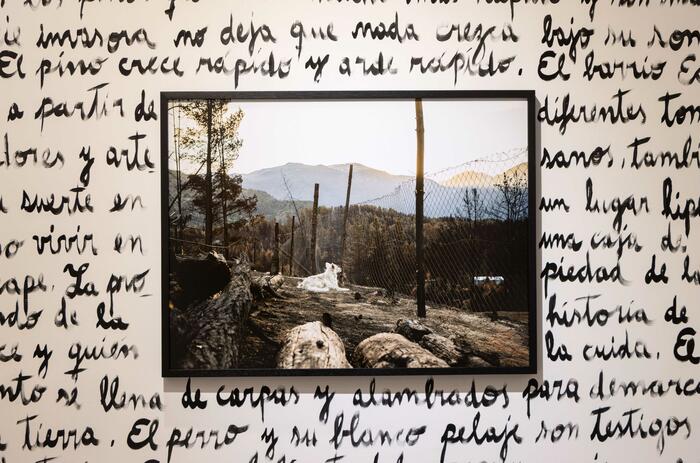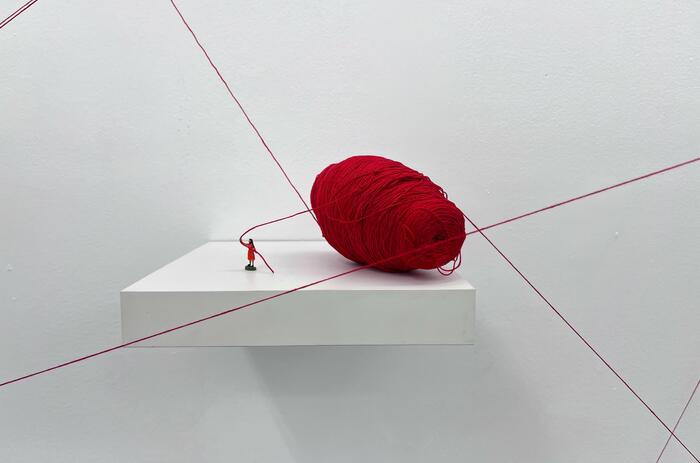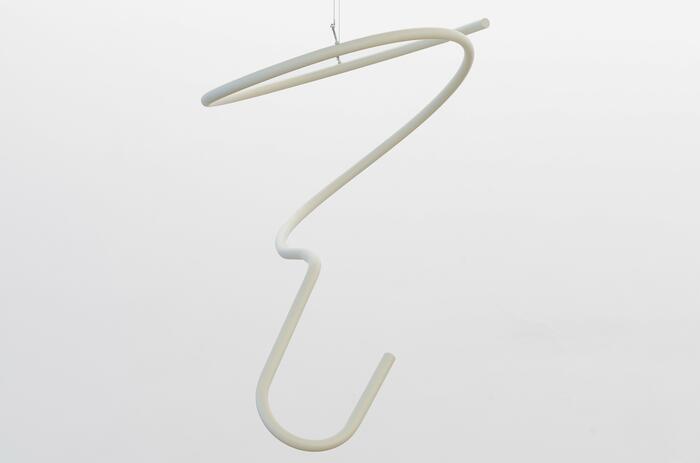TRANSITORY BOUNDARIES: THE LIMITS OF SPACE, OBJECTS AND IDENTITY.
As part of Open House Festival, an event that celebrates architecture, history and culture, four Argentine artists - Martín Cordiano, Sara Sahores, Ignacio Unrrein and Mariela Vita - intervened the space of the Argentine Ambassador's Residence in London, addressing themes such as transition, domesticity and barriers. Curated by Federika Chaimowicz, Carolina Orlando, Mora Pranteda and Pilar Seivane.

The Argentine Ambassador's residence in London opens to the public as the setting for the exhibition Transitory Boundaries. From September 14 to 22, 2024, the embassy is transformed into a space for artistic reflection where four Argentine artists explore the distances and connections between the private and the public, the domestic and the urban.
The exhibition, curated by Federika Chaimowicz, Carolina Orlando, Mora Pranteda and Pilar Seivane, presents works that interact with each other and with the particular context of the house-embassy. This combination reflects the very nature of the embassy: a space full of intertwined meanings between countries.
In the garden of the residence, Untitled by Ignacio Unrrein focuses on urban facades, inspired by his project Tapiar Buenos Aires, which investigates the walls and barriers that transform the architecture of his hometown (Buenos Aires). In his intervention at the residence, Unrrein transfers the idea of the wall -a barrier that hides but also protects- to a London context.
-
Sara Sahores. Installation view. “Transitory Boundaries” at Argentine Embassy. Photos by Sara Sahores
-
Sara Sahores. Installation view. “Transitory Boundaries” at Argentine Embassy. Photos by Sara Sahores
-
Mariela Vita. Installation view. “Transitory Boundaries” at Argentine Embassy. Photos by Sara Sahores
-
Mariela Vita. Installation view. “Transitory Boundaries” at Argentine Embassy. Photos by Sara Sahores
-
Martín Cordiano. Installation view. “Transitory Boundaries” at Argentine Embassy. Photos by Sara Sahores
-
Martín Cordiano. Installation view. “Transitory Boundaries” at Argentine Embassy. Photos by Sara Sahores
-
Ignacio Unrrein. Installation view. “Transitory Boundaries” at Argentine Embassy. Photos by Sara Sahores
-
Sara Sahores. Installation view. “Transitory Boundaries” at Argentine Embassy. Photos by Sara Sahores
Martín Cordiano, on the other hand, intervenes in the interior space of the residence with a series of decontextualized furniture. In his work Host, domestic objects become motifs for contemplation. Through this exercise, Cordiano suggests new ways of inhabiting one's home, endowing the furniture with a ritualistic dimension that invites to reflect on how spaces and objects affect us.
Sara Sahores explores the reappropriation of historical images in her work On Stealing 1. Sahores takes fragments of baroque works and reinserts them into the present, challenging the traditional role of the photographer as a distant observer. In her work, she questions the male gaze that has predominated in the history of art, especially in the portrayal of the female body. By positioning herself from a critical perspective, Sahores dialogues not only with the images she selects, but also with the embassy as a space charged with historical meanings and power.
Mariela Vita presents an installation that plays with the idea of animism, where objects acquire an aura and are perceived as living entities. In her work, Vita combines Japanese and Argentine cultural references, creating a map of objects. Her work connects with the duality of the embassy, a place where different identities and narratives converge.
Related Topics
May interest you

ARDE is the exhibition with Alejandro Chaskielberg and Don Rouch, guest artist, that brings together a series of works on which they have recently collaborated.
ARDE - ALEKANDRO CHASKIELBERG'S PROJECT AT GACHI PRIETO

ARDE is the exhibition with Alejandro Chaskielberg and Don Rouch, guest artist, that brings together a series of works on which they have recently collaborated.
ARDE - ALEKANDRO CHASKIELBERG'S PROJECT AT GACHI PRIETO

Rolf Art presented Marcelo Brodsky's exhibition MARTIRIO, in collaboration with artists Fernando Bryce, Martín Kovensky and Fredi Casco; supported by a research and conceptual approach by José Emilio Burucúa and Carles Guerra.

Liliana Porter (Buenos Aires, Argentina, 1941) has a long history shared with Espacio Minimo. The Madrid gallery pampers every move and celebrates the extensive relationship with the Argentinean artist, always offering her the possibility of receiving her work and witnessing its evolution. For the opening of the space's season, the landing is called Otros cuentos inconclusos, a new proposal that deals with representation and two dimensional axes —space and time— that bear witness to many of the questions raised about human relations.
THE UNFINISHED STORIES OF LILIANA PORTER
Liliana Porter (Buenos Aires, Argentina, 1941) has a long history shared with Espacio Minimo. The Madrid gallery pampers every move and celebrates the extensive relationship with the Argentinean artist, always offering her the possibility of receiving her work and witnessing its evolution. For the opening of the space's season, the landing is called Otros cuentos inconclusos, a new proposal that deals with representation and two dimensional axes —space and time— that bear witness to many of the questions raised about human relations.

The Appearance: Art of the Asian Diaspora in Latin America & the Caribbean is the first exhibition in New York City at Americas Society to center the artistic production of the Asian diaspora in the region from the 1940s to the present. Focusing on postwar and contemporary art, the exhibition showcases the work of thirty artists from fifteen countries working in a range of artistic mediums including painting, sculpture, performance, photography, and video, to shed light into strategies and themes that resonate across a wide array of Asian diasporic practice throughout Latin America and the Caribbean.
ART OF THE ASIAN DIASPORA IN LATIN AMERICA & THE CARIBBEAN
The Appearance: Art of the Asian Diaspora in Latin America & the Caribbean is the first exhibition in New York City at Americas Society to center the artistic production of the Asian diaspora in the region from the 1940s to the present. Focusing on postwar and contemporary art, the exhibition showcases the work of thirty artists from fifteen countries working in a range of artistic mediums including painting, sculpture, performance, photography, and video, to shed light into strategies and themes that resonate across a wide array of Asian diasporic practice throughout Latin America and the Caribbean.

The Museo Moderno de Buenos Aires inaugurated Celina Eceiza: Ofrenda, the artist's first solo museum exhibition. It is an immersive project that was produced by the museum in its entirety. The exhibition is curated by Jimena Ferreiro.
CELINA ECEIZA: BODIES IN TRANSFORMATION
The Museo Moderno de Buenos Aires inaugurated Celina Eceiza: Ofrenda, the artist's first solo museum exhibition. It is an immersive project that was produced by the museum in its entirety. The exhibition is curated by Jimena Ferreiro.

This year, Pinta BAphoto will hold its twentieth edition with new curatorial proposals to continue celebrating photography in Latin America. Based in Buenos Aires, the fair presents the new RADAR section, curated by Sebastián Vidal Mackinson.
PINTA BAphoto 2024: NEW RADAR SECTION
This year, Pinta BAphoto will hold its twentieth edition with new curatorial proposals to continue celebrating photography in Latin America. Based in Buenos Aires, the fair presents the new RADAR section, curated by Sebastián Vidal Mackinson.

ARDE is the exhibition with Alejandro Chaskielberg and Don Rouch, guest artist, that brings together a series of works on which they have recently collaborated.
ARDE - ALEKANDRO CHASKIELBERG'S PROJECT AT GACHI PRIETO

Rolf Art presented Marcelo Brodsky's exhibition MARTIRIO, in collaboration with artists Fernando Bryce, Martín Kovensky and Fredi Casco; supported by a research and conceptual approach by José Emilio Burucúa and Carles Guerra.

Liliana Porter (Buenos Aires, Argentina, 1941) has a long history shared with Espacio Minimo. The Madrid gallery pampers every move and celebrates the extensive relationship with the Argentinean artist, always offering her the possibility of receiving her work and witnessing its evolution. For the opening of the space's season, the landing is called Otros cuentos inconclusos, a new proposal that deals with representation and two dimensional axes —space and time— that bear witness to many of the questions raised about human relations.
THE UNFINISHED STORIES OF LILIANA PORTER
Liliana Porter (Buenos Aires, Argentina, 1941) has a long history shared with Espacio Minimo. The Madrid gallery pampers every move and celebrates the extensive relationship with the Argentinean artist, always offering her the possibility of receiving her work and witnessing its evolution. For the opening of the space's season, the landing is called Otros cuentos inconclusos, a new proposal that deals with representation and two dimensional axes —space and time— that bear witness to many of the questions raised about human relations.

The Appearance: Art of the Asian Diaspora in Latin America & the Caribbean is the first exhibition in New York City at Americas Society to center the artistic production of the Asian diaspora in the region from the 1940s to the present. Focusing on postwar and contemporary art, the exhibition showcases the work of thirty artists from fifteen countries working in a range of artistic mediums including painting, sculpture, performance, photography, and video, to shed light into strategies and themes that resonate across a wide array of Asian diasporic practice throughout Latin America and the Caribbean.
ART OF THE ASIAN DIASPORA IN LATIN AMERICA & THE CARIBBEAN
The Appearance: Art of the Asian Diaspora in Latin America & the Caribbean is the first exhibition in New York City at Americas Society to center the artistic production of the Asian diaspora in the region from the 1940s to the present. Focusing on postwar and contemporary art, the exhibition showcases the work of thirty artists from fifteen countries working in a range of artistic mediums including painting, sculpture, performance, photography, and video, to shed light into strategies and themes that resonate across a wide array of Asian diasporic practice throughout Latin America and the Caribbean.

The Museo Moderno de Buenos Aires inaugurated Celina Eceiza: Ofrenda, the artist's first solo museum exhibition. It is an immersive project that was produced by the museum in its entirety. The exhibition is curated by Jimena Ferreiro.
CELINA ECEIZA: BODIES IN TRANSFORMATION
The Museo Moderno de Buenos Aires inaugurated Celina Eceiza: Ofrenda, the artist's first solo museum exhibition. It is an immersive project that was produced by the museum in its entirety. The exhibition is curated by Jimena Ferreiro.

This year, Pinta BAphoto will hold its twentieth edition with new curatorial proposals to continue celebrating photography in Latin America. Based in Buenos Aires, the fair presents the new RADAR section, curated by Sebastián Vidal Mackinson.
PINTA BAphoto 2024: NEW RADAR SECTION
This year, Pinta BAphoto will hold its twentieth edition with new curatorial proposals to continue celebrating photography in Latin America. Based in Buenos Aires, the fair presents the new RADAR section, curated by Sebastián Vidal Mackinson.

ARDE is the exhibition with Alejandro Chaskielberg and Don Rouch, guest artist, that brings together a series of works on which they have recently collaborated.
ARDE - ALEKANDRO CHASKIELBERG'S PROJECT AT GACHI PRIETO

Rolf Art presented Marcelo Brodsky's exhibition MARTIRIO, in collaboration with artists Fernando Bryce, Martín Kovensky and Fredi Casco; supported by a research and conceptual approach by José Emilio Burucúa and Carles Guerra.

Liliana Porter (Buenos Aires, Argentina, 1941) has a long history shared with Espacio Minimo. The Madrid gallery pampers every move and celebrates the extensive relationship with the Argentinean artist, always offering her the possibility of receiving her work and witnessing its evolution. For the opening of the space's season, the landing is called Otros cuentos inconclusos, a new proposal that deals with representation and two dimensional axes —space and time— that bear witness to many of the questions raised about human relations.
THE UNFINISHED STORIES OF LILIANA PORTER
Liliana Porter (Buenos Aires, Argentina, 1941) has a long history shared with Espacio Minimo. The Madrid gallery pampers every move and celebrates the extensive relationship with the Argentinean artist, always offering her the possibility of receiving her work and witnessing its evolution. For the opening of the space's season, the landing is called Otros cuentos inconclusos, a new proposal that deals with representation and two dimensional axes —space and time— that bear witness to many of the questions raised about human relations.

The Appearance: Art of the Asian Diaspora in Latin America & the Caribbean is the first exhibition in New York City at Americas Society to center the artistic production of the Asian diaspora in the region from the 1940s to the present. Focusing on postwar and contemporary art, the exhibition showcases the work of thirty artists from fifteen countries working in a range of artistic mediums including painting, sculpture, performance, photography, and video, to shed light into strategies and themes that resonate across a wide array of Asian diasporic practice throughout Latin America and the Caribbean.
ART OF THE ASIAN DIASPORA IN LATIN AMERICA & THE CARIBBEAN
The Appearance: Art of the Asian Diaspora in Latin America & the Caribbean is the first exhibition in New York City at Americas Society to center the artistic production of the Asian diaspora in the region from the 1940s to the present. Focusing on postwar and contemporary art, the exhibition showcases the work of thirty artists from fifteen countries working in a range of artistic mediums including painting, sculpture, performance, photography, and video, to shed light into strategies and themes that resonate across a wide array of Asian diasporic practice throughout Latin America and the Caribbean.

The Museo Moderno de Buenos Aires inaugurated Celina Eceiza: Ofrenda, the artist's first solo museum exhibition. It is an immersive project that was produced by the museum in its entirety. The exhibition is curated by Jimena Ferreiro.
CELINA ECEIZA: BODIES IN TRANSFORMATION
The Museo Moderno de Buenos Aires inaugurated Celina Eceiza: Ofrenda, the artist's first solo museum exhibition. It is an immersive project that was produced by the museum in its entirety. The exhibition is curated by Jimena Ferreiro.

This year, Pinta BAphoto will hold its twentieth edition with new curatorial proposals to continue celebrating photography in Latin America. Based in Buenos Aires, the fair presents the new RADAR section, curated by Sebastián Vidal Mackinson.
PINTA BAphoto 2024: NEW RADAR SECTION
This year, Pinta BAphoto will hold its twentieth edition with new curatorial proposals to continue celebrating photography in Latin America. Based in Buenos Aires, the fair presents the new RADAR section, curated by Sebastián Vidal Mackinson.

ARDE is the exhibition with Alejandro Chaskielberg and Don Rouch, guest artist, that brings together a series of works on which they have recently collaborated.
ARDE - ALEKANDRO CHASKIELBERG'S PROJECT AT GACHI PRIETO

Rolf Art presented Marcelo Brodsky's exhibition MARTIRIO, in collaboration with artists Fernando Bryce, Martín Kovensky and Fredi Casco; supported by a research and conceptual approach by José Emilio Burucúa and Carles Guerra.

Liliana Porter (Buenos Aires, Argentina, 1941) has a long history shared with Espacio Minimo. The Madrid gallery pampers every move and celebrates the extensive relationship with the Argentinean artist, always offering her the possibility of receiving her work and witnessing its evolution. For the opening of the space's season, the landing is called Otros cuentos inconclusos, a new proposal that deals with representation and two dimensional axes —space and time— that bear witness to many of the questions raised about human relations.
THE UNFINISHED STORIES OF LILIANA PORTER
Liliana Porter (Buenos Aires, Argentina, 1941) has a long history shared with Espacio Minimo. The Madrid gallery pampers every move and celebrates the extensive relationship with the Argentinean artist, always offering her the possibility of receiving her work and witnessing its evolution. For the opening of the space's season, the landing is called Otros cuentos inconclusos, a new proposal that deals with representation and two dimensional axes —space and time— that bear witness to many of the questions raised about human relations.

The Appearance: Art of the Asian Diaspora in Latin America & the Caribbean is the first exhibition in New York City at Americas Society to center the artistic production of the Asian diaspora in the region from the 1940s to the present. Focusing on postwar and contemporary art, the exhibition showcases the work of thirty artists from fifteen countries working in a range of artistic mediums including painting, sculpture, performance, photography, and video, to shed light into strategies and themes that resonate across a wide array of Asian diasporic practice throughout Latin America and the Caribbean.
ART OF THE ASIAN DIASPORA IN LATIN AMERICA & THE CARIBBEAN
The Appearance: Art of the Asian Diaspora in Latin America & the Caribbean is the first exhibition in New York City at Americas Society to center the artistic production of the Asian diaspora in the region from the 1940s to the present. Focusing on postwar and contemporary art, the exhibition showcases the work of thirty artists from fifteen countries working in a range of artistic mediums including painting, sculpture, performance, photography, and video, to shed light into strategies and themes that resonate across a wide array of Asian diasporic practice throughout Latin America and the Caribbean.

The Museo Moderno de Buenos Aires inaugurated Celina Eceiza: Ofrenda, the artist's first solo museum exhibition. It is an immersive project that was produced by the museum in its entirety. The exhibition is curated by Jimena Ferreiro.
CELINA ECEIZA: BODIES IN TRANSFORMATION
The Museo Moderno de Buenos Aires inaugurated Celina Eceiza: Ofrenda, the artist's first solo museum exhibition. It is an immersive project that was produced by the museum in its entirety. The exhibition is curated by Jimena Ferreiro.

This year, Pinta BAphoto will hold its twentieth edition with new curatorial proposals to continue celebrating photography in Latin America. Based in Buenos Aires, the fair presents the new RADAR section, curated by Sebastián Vidal Mackinson.
PINTA BAphoto 2024: NEW RADAR SECTION
This year, Pinta BAphoto will hold its twentieth edition with new curatorial proposals to continue celebrating photography in Latin America. Based in Buenos Aires, the fair presents the new RADAR section, curated by Sebastián Vidal Mackinson.

ARDE is the exhibition with Alejandro Chaskielberg and Don Rouch, guest artist, that brings together a series of works on which they have recently collaborated.
ARDE - ALEKANDRO CHASKIELBERG'S PROJECT AT GACHI PRIETO

Rolf Art presented Marcelo Brodsky's exhibition MARTIRIO, in collaboration with artists Fernando Bryce, Martín Kovensky and Fredi Casco; supported by a research and conceptual approach by José Emilio Burucúa and Carles Guerra.

Liliana Porter (Buenos Aires, Argentina, 1941) has a long history shared with Espacio Minimo. The Madrid gallery pampers every move and celebrates the extensive relationship with the Argentinean artist, always offering her the possibility of receiving her work and witnessing its evolution. For the opening of the space's season, the landing is called Otros cuentos inconclusos, a new proposal that deals with representation and two dimensional axes —space and time— that bear witness to many of the questions raised about human relations.
THE UNFINISHED STORIES OF LILIANA PORTER
Liliana Porter (Buenos Aires, Argentina, 1941) has a long history shared with Espacio Minimo. The Madrid gallery pampers every move and celebrates the extensive relationship with the Argentinean artist, always offering her the possibility of receiving her work and witnessing its evolution. For the opening of the space's season, the landing is called Otros cuentos inconclusos, a new proposal that deals with representation and two dimensional axes —space and time— that bear witness to many of the questions raised about human relations.

The Appearance: Art of the Asian Diaspora in Latin America & the Caribbean is the first exhibition in New York City at Americas Society to center the artistic production of the Asian diaspora in the region from the 1940s to the present. Focusing on postwar and contemporary art, the exhibition showcases the work of thirty artists from fifteen countries working in a range of artistic mediums including painting, sculpture, performance, photography, and video, to shed light into strategies and themes that resonate across a wide array of Asian diasporic practice throughout Latin America and the Caribbean.
ART OF THE ASIAN DIASPORA IN LATIN AMERICA & THE CARIBBEAN
The Appearance: Art of the Asian Diaspora in Latin America & the Caribbean is the first exhibition in New York City at Americas Society to center the artistic production of the Asian diaspora in the region from the 1940s to the present. Focusing on postwar and contemporary art, the exhibition showcases the work of thirty artists from fifteen countries working in a range of artistic mediums including painting, sculpture, performance, photography, and video, to shed light into strategies and themes that resonate across a wide array of Asian diasporic practice throughout Latin America and the Caribbean.

The Museo Moderno de Buenos Aires inaugurated Celina Eceiza: Ofrenda, the artist's first solo museum exhibition. It is an immersive project that was produced by the museum in its entirety. The exhibition is curated by Jimena Ferreiro.
CELINA ECEIZA: BODIES IN TRANSFORMATION
The Museo Moderno de Buenos Aires inaugurated Celina Eceiza: Ofrenda, the artist's first solo museum exhibition. It is an immersive project that was produced by the museum in its entirety. The exhibition is curated by Jimena Ferreiro.

This year, Pinta BAphoto will hold its twentieth edition with new curatorial proposals to continue celebrating photography in Latin America. Based in Buenos Aires, the fair presents the new RADAR section, curated by Sebastián Vidal Mackinson.
PINTA BAphoto 2024: NEW RADAR SECTION
This year, Pinta BAphoto will hold its twentieth edition with new curatorial proposals to continue celebrating photography in Latin America. Based in Buenos Aires, the fair presents the new RADAR section, curated by Sebastián Vidal Mackinson.




